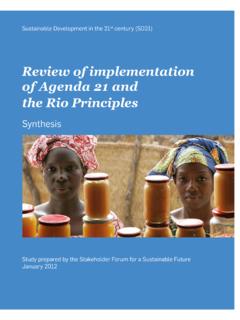Transcription of 2020 World Youth Report - Welcome to the United Nations
1 World Youth REPORTYOU T H SOCIAL ENTREPRENEURSHIP AND THE 2030 agenda World Youth Report Youth SOCIAL ENTREPRENEURSHIP AND THE 2030 AGENDAW orld Youth ReportPublished by the United Nations New York, New York 10017 United States of AmericaUnited Nations Publication Sales No.: ISBN: 978-92-1-130406-0 eISBN: 978-92-1-005002-9 Print ISSN: 2411-8958 Online ISSN: 2411-8974 Copyright United Nations , 2020 All rights reservedAll queries or rights and licenses including subsidiary rights should be addressed to United Nations Publications, 405 E. 42nd Street (Room S-09-FW001), New York, NY 10017, United States of America; email: website: Note: The designations employed and the presentation of the material in this publication do not imply the expression of any opinion whatsoever on the part of the Secretariat of the United Nations concerning the legal status of any country or territory or of its authorities, or concerning the delimitations of its frontiers. The term country as used in the text of the present Report also refers, as appropriate, to territories or areas.
2 The designations of country groups in the text and the tables are intended solely for statistical or analytical convenience and do not necessarily express a judgment about the stage reached by a particular country or area in the development process. Mention of the names of firms and commercial products does not imply the endorsement of the United Nations . Technical Note: In this publication, unless otherwise indicated, the term Youth refers to all those between the ages of 15 and 24, as reflected in the World Programme of Action for Youth . The term young people may be used interchangeably with the word Youth . Disclaimer: The views expressed in the contributions to this publication are those of the individual authors and do not imply the expression of any opinion on the part of the United Nations or of the organizations with which the authors are affiliated. Front Cover Photo: ILO / Marcel CrozetDesign: Graphic Design Unit, Outreach Division, Department of Global Communications, United Nations , New YorkThe Department of Economic and Social Affairs of the United Nations Secretariat is a vital interface between global policies in the economic, social and environmental spheres and national action.
3 The Department works in three main interlinked areas: it compiles, generates and analyses a wide range of economic, social and environmental data and information on which Member States of the United Nations draw to review common problems and to take stock of policy options; it facilitates the negotiations of Member States in many intergovernmental bodies on joint courses of action to address ongoing or emerging global challenges; and it advis-es interested Governments on the ways and means of translating policy frameworks developed in United Nations conferences and summits into programmes at the country level and, through technical assistance, helps build national Youth Report : Youth Social Entrepreneurship and the 2030 AgendaACKNOWLEDGEMENTSThe World Youth Report , prepared biennially, is the flag-ship publication on Youth issues of the Department of Economic and Social Affairs of the United Nations Secretariat.
4 The World Youth Report : Youth Social Entrepreneurship and the 2030 agenda is a product of the efforts, contributions and support of many peo-ple and organizations. The Report was prepared by the Division for Inclusive Social Development, led by Director Daniela Bas. The Report represents a collaborative effort and reflects the input and contributions of experts in the field of Youth social entrepreneurship and development. Much of the research and writing was carried out by Isabelle Legare (Social Affairs Officer) and Mario Spiezio (Associate Social Affairs Officer) under the guidance of Nicola Shepherd (Chief of the Programme on Youth Unit). The United Nations Department of Economic and Social Affairs would like to extend very special thanks to the Report s contributing authors; Tina P. Kruse (Professor in the Department of Educational Studies at Macalester College), Willem (Wim) Naud (Professor of Business and Entrepreneurship at Maastricht University and Visiting Professor in Technology, Innovation, Marketing and Entrepreneurship at RWTH Aachen University), and Virva Salmivaara (Post-doctoral researcher in Entrepreneurship and Innovation Management at Aalto University School of Business in Helsinki).
5 The Report also benefited from the contributions of a group of experts which included Ellen Chilemba (Founder and Executive Director at Tiwale), Luisa De Simone, (in her capacity of co-author of the European Learning for Youth in Social Entrepreneurship (ELYSE) Final Report ), Sarah Fotheringham (Research and Evaluation Consultant), Lani Fraizer (Professor/Principal Digital Transformation, Workforce Wellbeing, Future of Work, Carnegie Mellon University Heinz College of Information Systems and Public Policy), Diane Holt (Professor of Entrepreneurship, Director Centre for Enterprise and Entrepreneurship Studies at University of Leeds), Sabine Mensah (Digital Financial Service specialist for the United Nations Capital Development Fund), Pezana Rexha (Founder and CEO of Pana: Storytelling Furniture), and Jana Svedova (Director, Impact Investments and Social Venture Stream Lead at the University of British Columbia and co-founder of Synergy Social Ventures). In addition, a number of colleagues within the Division for Inclusive Social Development, including Sophie Greenfield, Meriam Gueziel, Xavier Larsen and Anna Trub contributed to the Report .
6 Constructive feedback from many colleagues within and outside the Department of Economic and Social Affairs also sup-ported the preparation of the Report . Finally, a sincere thank you is extended to Terri Lore, who patiently edited the Report . We are grateful to all others who have contributed to this Youth Report : Youth Social Entrepreneurship and the 2030 AgendaCONTENTSACKNOWLEDGEMENTS ..ivEXPLANATORY NOTES ..ixAbbreviations used in the Report ..ixNotes on regional, country and area groupings and subgroupings ..xEXECUTIVE SUMMARY ..1 Introduction ..1 Social entrepreneurship ..1 Youth development and participation ..2 Youth social entrepreneurship: potential and challenges ..2 Leveraging new technologies ..3 Recommendations ..3 Conclusion ..3 INTRODUCTION ..5 CHAPTER 1: SOCIAL ENTREPRENEURSHIP ..9 Introduction .. The rise of social entrepreneurship .. Defining social entrepreneurship .. Comparing social enterprises with other entities .. Social entrepreneurship and the 2030 agenda : a first look.
7 Social entrepreneurship and individuals at the last mile .. Measuring the social impact .. Overview of some challenges .. What about young people? ..36 Conclusion ..37 CHAPTER 2: Youth DEVELOPMENT AND PARTICIPATION ..39 Introduction .. Youth development and participation at a glance .. Youth employment at a glance .. Social entrepreneurship: a viable employment route for Youth ? .. Social entrepreneurship: an efficient development platform for Youth ? .. Social entrepreneurship: a practical pathway to social change for Youth ? .. Social entrepreneurship: supporting Youth access to networks and resources? .. Social entrepreneurship: an avenue for Youth to contribute to social change? ..61 Conclusion ..63viWORLD Youth Report : Youth Social Entrepreneurship and the 2030 AgendaCHAPTER 3: Youth SOCIAL ENTREPRENEURSHIP: POTENTIAL AND CHALLENGES ..65 Introduction .. SWOT analysis of young people as social entrepreneurs and relevant external factors.
8 Strengths .. Weaknesses .. Opportunities .. Threats .. What can help Youth launch and grow social enterprises? ..74 Conclusion ..85 CHAPTER 4: LEVERAGING NEW TECHNOLOGIES FOR Youth SOCIAL ENTREPRENEURSHIP .89 Introduction .. New technologies and inequalities .. New technologies and the Sustainable Development Goals .. Opportunities for young social entrepreneurs ..93 Conclusion ..98 CHAPTER 5: RECOMMENDATIONS FOR AN ENABLING Youth SOCIAL ENTREPRENEURSHIP ECOSYSTEM ..103 Introduction .. Recommendations .. Optimizing the overall business environment .. Strengthening entrepreneurial education and training .. Tailoring support networks to the needs of young social entrepreneurs .. Ensuring access to financial services and products .. Transforming innovation systems .. Changing the narrative ..110 Conclusion ..111 CONCLUSION ..113 REFERENCES ..116viiWORLD Youth Report : Youth Social Entrepreneurship and the 2030 AgendaBOXESBox 1.
9 What is an entrepreneurship ecosystem? ..7 Box 2. The Orenda Tribe: Art For Hope in Jordan and Lebanon ..24 Box 3. Tiwale: helping women in Malawi ..26 Box 4. Agruppa ..34 Box 5. Youth Venture ..71 Box 6. Jamaica Social Stock Exchange ..73 Box 7. The cooperative movement ..76 Box 8. Incubators and accelerators ..78 Box 9. UPSHIFT ..80 Box 10. The importance of financial literacy for young social entrepreneurs ..83 Box 11. What works in Youth entrepreneurship and self-employment?..85 Box 12. Zipline: drones supporting health services in remote locations ..98 Box 13. Tykn: journey of a young tech social entrepreneur ..99 BOXES, FIGURES AND TABLESFIGURESF igure 1. GDP per capita against the nascent social entrepreneurship rate, 2015 ..12 Figure 2. Relationship between nascent social entrepreneurial activity and operational social entrepreneurial activity ..13 Figure 3. Labour force participation rates within the age Groups 15-24 and 25+, by region, 2000-2020 ..45 Figure 4.
10 Working poverty rates within the age Groups 15-24 and 25+, by region, 2000-2020 ..46 Figure 5. Rates of unemployment within the age Groups 15-24 and 25+, by region, 2000-2020 ..47 Figure 6. Youth NEET rates, most recent estimates (2000-2018) ..48 Figure 7. Relationship between ease of doing business index rankings and Youth NEET rates, 2017 ..50 Figure 8. Relationship between GDP per capita and the Youth NEET rate, 2018 or most recent estimate ..51 Figure 9. Relationship between income inequality and the Youth NEET rate, 2018 or most recent estimate ..52 Figure 10. Relationship between peace and the Youth NEET rate, 2018 or most recent estimate ..53 Figure 11. Relationship between the adoption of digital technology and the utilization of the talents of Youth (aged 15-24) across the World ..100 TABLEST able 1. Projected population of Youth aged 15 to 24 years in 2020, 2030 and 2050 ..40 Table 2. Countries with the highest Youth NEET rates (2018 or most recent estimates) ..49 Table 3.















